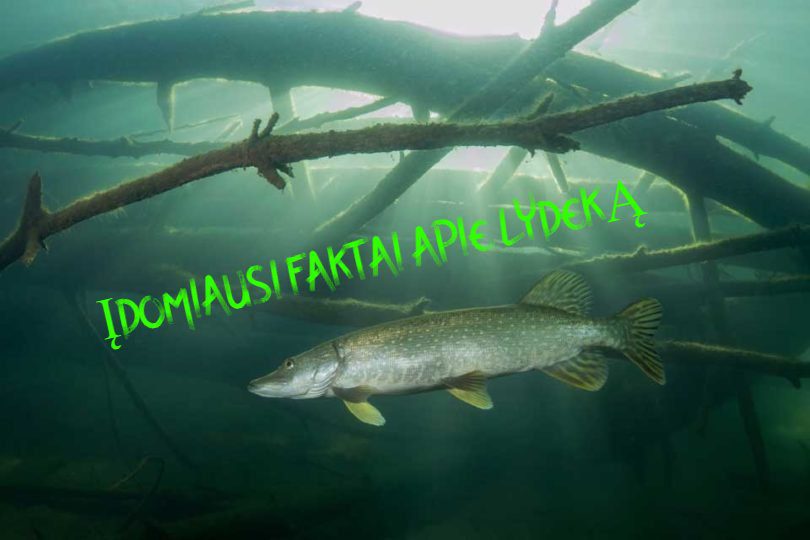Lydekos yra agresyvios gėlavandenės žuvys, mėgstančios vienišą gyvenimo būdą. Tačiau ką mes žinome apie lydekas, be to, kad jose gausu baltymų ir širdžiai naudingų omega-3 riebalų? Nedaug! Ištaisykime šią klaidą kartu. Čia pateikti, mano manymu, įdomiausi faktai apie lydeką.
Faktai apie lydeką
Nr. 1
Lydeka turi ilgą, palyginti plokščią kūną su margomis arba dėmėtomis juostelėmis nugaroje, kurios suteikia jai maskavimą tarp upių ir ežerų dugno augmenijos. Kaip ir pirštų atspaudai, šie raštai yra visiškai unikalūs kiekvienai žuviai.
Nr. 2
Maži žvyneliai dažniausiai būna melsvai pilki, gelsvai žali arba rudi, kurie prie žuvies dugno tampa šviesesni.
Nr. 3
Lydekos būna su siaura, smailia galva su didelėmis akimis. Ji turi vieną nugaros ir vieną analinį peleką prie uodegos, taip pat dvi poras pelekų prie galvos ir pilvo.
Nr. 4
Lydekos gali užaugti iki 1,5 metro ilgio, tačiau dažniausiai vidutinis individų ilgis siekia 60–90 cm.
Faktai apie lydeką – Nr. 5
Jos gyvena lėtai tekančiose gėlo vandens upėse, ežeruose ir kanaluose. Ją galite rasti daugumoje vandens telkinių, jei jų vandenys yra gerai prisotinti deguonimi ir nėra per daug rūgštūs. Lydekos mėgsta seklias vietas su gausia augmenija. Šiuos augalus žuvys naudoja kaip slėptuves medžiodamos. Ji bando netikėtai sugauti auką, vengdama ilgų, energiją eikvojančių gaudynių.
Nr. 6
Lydeka – nepasotinamas medžiotojas. Ji griebia grobį per visą kūną, imobilizuoja jį smailiais, atgal atsuktais dantimis, o tada pasuka grobį galva į priekį, kad nurytų jį visą. Lydeka minta smulkiomis žuvelėmis, varlėmis, tritonais, vėžiais, vabzdžiais, dėlėmis, graužikais, smulkiais žinduoliais ir paukščiais.
Nr. 7
Kai kurios lydekos sveria iki 35 kg. Jos gali valgyti grobį iki pusės savo svorio!
Nr. 8
Yra keturi pagrindiniai lydekų tipai: šiaurinė, pietinė, Amūrinė ir Akvitanė. Pastebėtina, kad pastarasis pirmą kartą buvo aptiktas pietvakariniame Prancūzijos regione 2014 m., todėl iki šiol mažai tyrinėtas.
Nr. 9
Didelės akys lydekai suteikia binokulinį regėjimą. Kai kurios rūšys turi judamą akį, galinčią matyti beveik bet kuria kryptimi.
Faktai apie lydeką – Nr. 10
Lydekų nerštas dažniausiai vyksta nuo vasario iki balandžio pabaigos. Tikslus laikas priklauso nuo vandens temperatūros, kuri turėtų siekti 6-12 °C. Poravimosi elgesys skiriasi priklausomai nuo rūšies. Pavyzdžiui, šiaurinės lydekos patinas gali paskatinti patelę išleisti ikrus, švelniai stumdamas juos į galvą. Tada patinas išleis savo spermą, kad apvaisintų kiaušinėlius.
Nr. 11
Nerštas dažniausiai vyksta gana sekliame vandenyje. Vienišos patelės dažnai grįžta į pageidaujamas nerštavietes lydimos 2–4 mažesnių patinų, vadinamų „Valetais“.
Nr. 12
Didelė patelė gali duoti nuo 200 000 iki 500 000 kiaušinėlių!
Nr. 13
Iš apvaisintų ikrų jaunos lydekos išsiris po kelių savaičių. Pažeidžiami ir vieniši, jie prisiriša prie žolių ir išgyvena ant trynio maišelio, kol vis dar neturi galimybės maitintis naudingesniu maistu. Kai jų burnos pagaliau išsivystys, jaunos žuvys pradės vartoti zooplanktoną (mažyčius vandens gyvūnus).
Nr. 14
Natūraliomis sąlygomis laisvai plaukiančių lervų išgyvenamumas svyruoja nuo 0,1 iki 5%. Išgyvenimo tikimybė maža dėl kanibalizmo, kitų žuvų, vandens paukščių ir vandens vabalų plėšrūnų.
Faktai apie lydeką – Nr. 15
Jaunos lydekos greitai auga ir 3 metų gali siekti 60 cm, patinai lytiškai subręsta 2 metų, o patelės 4 metų.
Nr. 16
Lydeka – idealus plėšrūnas, kuriam nereikia evoliucinių pokyčių. Rastos fosilijos rodo, kad dabartinė forma išliko daugiau nei 60 milijonų metų!
Nr. 17
Nepaisant populiarių įsitikinimų, lydekoms nereikia dažnai maitintis, kad išgyventų.
Nr. 18
Lydeka – protingas plėšrūnas, turintis galimybę po kurio laiko pakeisti kūno spalvą pagal besikeičiančią aplinką.
Nr. 19
Jutimo poros išsidėsčiusios palei žuvies snukutį ir apatinį žandikaulį, sulaiko kvapą ir vandens aplinkos vibraciją.
Faktai apie lydeką – Nr. 20
Didesnės patelės dažnai gaudo sergančias, mirštančias ir nugaišusias žuvis, kurios yra lengvas maisto šaltinis, ir tai darydamos prisiima medžiotojų vaidmenį, padedančios išlaikyti sveiką ir subalansuotą vandens telkinį.
Nr. 21
Vidutinė lydekos gyvenimo trukmė gamtoje yra 10–15 metų. Rekordininkas pagal amžių gyveno beveik 26 metus.
Nr. 22
Seni individai su amžiumi tampa rudi, o kartais ir pilki.
Nr. 23
Nepaisant agresyvumo, lydekų užpuolimo prieš žmones atvejų užfiksuota labai nedaug. Greičiausiai taip yra todėl, kad lydekai neįdomi kova su už ją daug didesniu padaru. Daugeliu atvejų lydeka mieliau bėga.
Nr. 24
Lydekos yra populiarios žuvys, gaudomos tiek komercinių, tiek sportinių meškeriotojų. Dėl taršos, pernelyg intensyvios žvejybos ir tinkamų veisimosi vietų trūkumo žuvų skaičius sparčiai mažėja.









